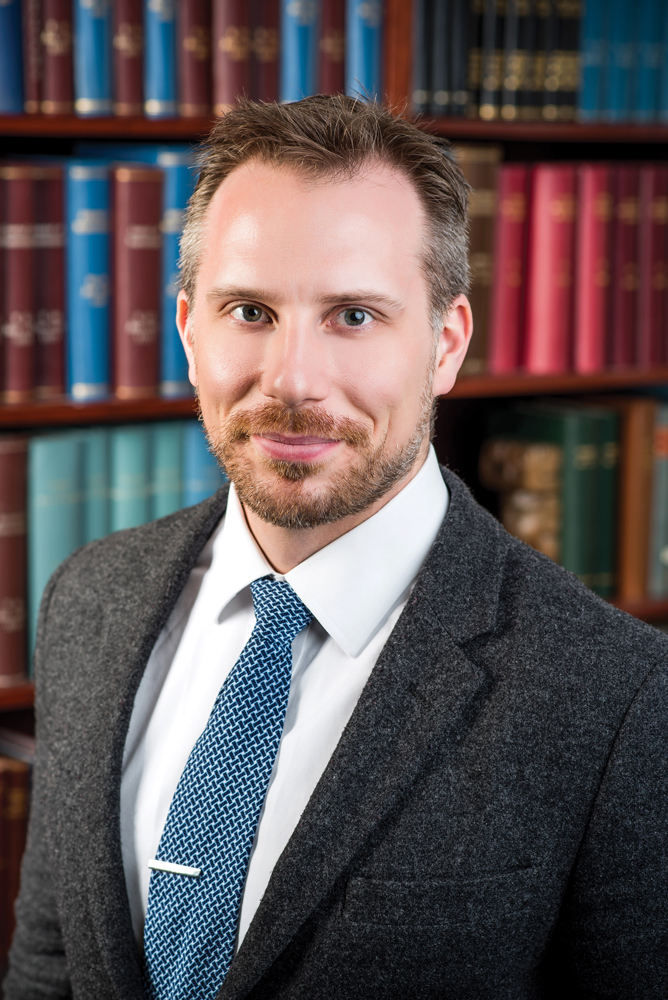 After a national search, Matthew Might was named the inaugural director of UAB’s Hugh Kaul Personalized Medicine Institute. When Matthew Might, Ph.D., looks at the biology of the human body, he doesn’t see cells or DNA. He sees a computer and individual programs. He sees a deep trove of data filed away in a personal operating system that is unique to each individual—data that can be mined to unlock potential treatments for a wide array of diseases, common and rare.
After a national search, Matthew Might was named the inaugural director of UAB’s Hugh Kaul Personalized Medicine Institute. When Matthew Might, Ph.D., looks at the biology of the human body, he doesn’t see cells or DNA. He sees a computer and individual programs. He sees a deep trove of data filed away in a personal operating system that is unique to each individual—data that can be mined to unlock potential treatments for a wide array of diseases, common and rare.
Might’s perception stems from his passion for computers. He received a master’s degree and Ph.D. in computer science from Georgia Tech, and spent nine years as a professor at the University of Utah’s School of Computing. But a turn of events in his personal life led Might to realize that his way of thinking can be beneficial in the world of medicine, particularly in the growing field of precision medicine.
Might is working on ways to use computational technologies such as genomic sequencing to discover the best way to treat a specific person’s specific disease. It is medicine at its most precise: customized treatment designed expressly for each individual.
“It’s the difference between treating the disease and treating the patient,” Might says. “I tell people that what I’m developing is the algorithm for precision medicine. It’s a computer program, but the input is the patient.”
This innovative approach led former President Barack Obama to appoint Might to the White House Precision Medicine Initiative in 2016. Might was also a visiting professor in the Department of Biomedical Informatics at Harvard Medical School, in addition to serving as a Presidential Scholar and associate professor in both computer science and pharmaceutical chemistry at the University of Utah.
Earlier this year, Might was named the inaugural director of the Hugh Kaul Personalized Medicine Institute at the UAB School of Medicine, a position he assumes July 1. He says the opportunity to come to UAB was attractive because he believes “this is an institution where I can collaborate to drive a vision for precision medicine.” It is a vision that came into stark focus for Might on one of the happiest days of his life: the day he first saw his son shed tears.
Diagnostic Wilderness
 The birth of Matt and Cristina Might’s first son Bertrand (bottom left) in 2007 brought joy and, later, concern when the child began to show signs of movement and other disorders. The couple’s efforts to help Bertrand in part led Matt to become a leader in precision medicine. Might and his wife, Cristina, celebrated the birth of their first child on Dec. 9, 2007. They named him Bertrand, in honor of British mathematician Bertrand Russell. But celebration soon turned to concern, as it quickly became apparent that something was wrong with the infant.
The birth of Matt and Cristina Might’s first son Bertrand (bottom left) in 2007 brought joy and, later, concern when the child began to show signs of movement and other disorders. The couple’s efforts to help Bertrand in part led Matt to become a leader in precision medicine. Might and his wife, Cristina, celebrated the birth of their first child on Dec. 9, 2007. They named him Bertrand, in honor of British mathematician Bertrand Russell. But celebration soon turned to concern, as it quickly became apparent that something was wrong with the infant.
Within weeks of his birth, Bertrand showed signs of having a movement disorder. His body twitched and shook. Eventually, he began having full-blown seizures every day. Often he would simply howl in distress, and attempts to comfort him just made him shriek even louder.
“He was a miserable kid—always in pain, never happy,” Might says.
Furthermore, Bertrand was unable to cry. He could scream and yell, but actual tears never formed in his eyes. This painfully despondent child could wail, but not weep.
The Mights spent the next four years on a diagnostic odyssey trying to figure out exactly what was wrong with their son. An MRI ruled out brain damage, and testing repeatedly disproved other theories. Eventually, as the medical professionals began to run out of suggestions, the Mights started doing their own research.
In 2012, the Mights and Bertrand all underwent exome sequencing—a type of DNA sequencing that focuses on the expressed genes in a genome, known as the exome—in an attempt to find any gene mutations that might have caused his disease. Sure enough, they discovered Bertrand had mutations that had destroyed the function of the NGLY1 gene.
“It turns out he was the first human ever diagnosed with missing this gene and to have it linked to a disease,” Might says. “Our son was literally patient zero. Then the question became, what do we do with that information? We now know the exact molecular cause of this disease. Can we treat it?”
The Mights then needed to better understand the constellation of disorders caused by the genetic mutation and pathways to potential therapies. To achieve that, they needed to attract the attention of researchers, pharmaceutical companies, and the FDA. To achieve that, they needed to find more people with this ultra-rare disease.
Years earlier, Might had created a viral phenomenon with an online blog post called “The Illustrated Guide to a Ph.D.,” which was eventually translated into dozens of languages. He took lessons he had learned about viral marketing, search engine optimization, and leveraging social media and applied them to his search for more people like Bertrand.
In May 2012, he posted an essay to his personal website titled “Hunting Down My Son’s Killer.” The post was shared on social media and Reddit within hours. The next day, Might was contacted by the editor of Gizmodo, an influential tech blog, who asked for permission to republish it. Within 24 hours, the post had gone viral.
The exposure worked. Over the next few months, Might was contacted by other families struggling with the NGLY1 deficiency and researchers volunteering to help. Further tests revealed that without a functioning NGLY1 gene, Bertrand was deficient in a sugar called N-acetylglucosamine, which is a derivative of glucose. Far from being a rare resource, N-acetylglucosamine can be purchased on Amazon. Might ordered some and, after taking it himself with no ill effects, he began giving it to his son.
A mere three days later, Might walked into his son’s room and witnessed an incredible sight: Bertrand was crying. Not yelling—crying, with actual tears rolling down his cheeks.
“It was amazing to walk in at that moment and see him crying,” Might says. “They may have just been tears, but they were an ocean of science for the disease. They unlocked so much about this disorder.”
Science Becomes Action
 The long, winding path to help Bertrand and other families looking for answers has led Might’s career in new, often surprising directions. The family’s story was told in a lengthy article in The New Yorker in 2014, which precipitated calls from Harvard Medical School and the Obama administration.
The long, winding path to help Bertrand and other families looking for answers has led Might’s career in new, often surprising directions. The family’s story was told in a lengthy article in The New Yorker in 2014, which precipitated calls from Harvard Medical School and the Obama administration.
“You could say I started focusing on precision medicine the moment he was born and we realized something wasn’t right,” Might says. “I couldn’t help but want to figure it out. When it’s your kid and you know there’s nobody else in the world who can do anything for him, you just start doing it yourself. That was my introduction to precision medicine.”
At its core, Might’s vision for precision medicine is simple: Because every person has certain unique characteristics within his or her molecular makeup, no medicine or treatment will work the same way on every person even if two people have the same type of disease. Rather than focus on the disease, one should focus on the patient and what is happening inside his or her cells.
“With precision medicine, we want to treat diseases at the root cause by focusing on individual genes driving the disease,” Might says. “When we design a therapy for you, we hit the genes that are driving your disease, and that can be totally different from patient to patient with the same disease.”
Precision PartnersPhilanthropic support has been key to the growth of UAB’s precision medicine programs. In 2015, the Hugh Kaul Foundation donated $7 million to establish the Hugh Kaul Personalized Medicine Institute at UAB. This followed nearly $9 million in gifts from the foundation to UAB, including the lead gift for the Hugh Kaul Human Genetics Building, home to an interdisciplinary group of faculty focused on basic laboratory and clinical research, patient care, and state-of-the-art genetic testing. Last year, the Altec Styslinger Foundation generously committed a transformational gift to assist with the construction of the Altec Styslinger Genomic Medicine and Data Sciences Building at UAB. The building is planned as part of a larger research and academic crescent, which has the potential to help UAB secure an estimated $48 million in additional NIH funding. The development has the potential to create hundreds of new jobs and have a substantial economic impact on the city of Birmingham, in addition to the disease-modifying and life-saving therapies that may result from research housed there. “This is the future of medicine, and thanks to the generosity of our philanthropic partners, UAB is positioned to lead the way in precision medicine,” says Selwyn M. Vickers, M.D., FACS, senior vice president for medicine and dean of the School of Medicine. “These initiatives will help us transform the advancement of medicine—expanding research into the genetic factors related to diseases and allowing us to precisely target treatments based on a patient’s unique genetic makeup. The knowledge gained will be transformative for Alabama and the nation.” |
For example, if a patient has lung cancer, gene sequencing of a tumor sample can tell doctors which genetic mutations are causing the cancer. “Every time you sequence a patient’s tumor, you get a snapshot of the genetic drivers of that patient’s cancer. And they can be completely different between any two patients, even if they both have the same type of cancer,” Might says. “Because there’s something completely different driving those cancers, the treatment might be completely different.”
Even if the ideal drug for a specific patient is not immediately apparent, Might says it is much easier to find the correct drug through precision medicine than through the trial-and-error approach that is commonly used.
“A big component of all this is going to be repurposing— testing drugs that are already FDA approved and finding out whether they have other effects that work for you and your condition,” Might says. “Most drugs don’t do only what they’re designed to do. They all have side effects, and sometimes those side effects are clinically beneficial for some other disease. We can take all these approved drugs and reuse them in very creative ways, for diseases they were never originally intended to treat but actually do.”
Of course, no patient wants to wade through medication after medication and their side effects, searching for one that helps him or her. That is where genomic testing puts the precision in precision medicine.
“We can take this giant FDA-approved library of several thousand drugs and drop them on a patient’s diseased cells, and see if anything pushes them back toward healthy,” Might says. “That’s going to be the essence of the early stages of precision medicine. We’re going to do a lot of that at UAB.”
What Lies Ahead
Might says drug discovery and development will likely also become more of a customized process, especially with rare genetic diseases. “Right now, a disease comes in to a pharmaceutical company. It goes through this entire process of screening and targeted identification and a series of clinical trials, and eventually a drug might pop out,” Might says. “The problem is it’s a risky endeavor, and you have to have these huge drug companies willing to shoulder the risk all the way through the process.
“So what’s going to happen is, you’re going to have firms and labs that will just do one part of the puzzle. They’ll do just the screening or just the targeted identification, and patients and patient foundations will push for drug development from stage to stage on their own.
“Patients are very motivated to move the process from stage to stage, whereas a drug company might just shut it down if something doesn’t work. So I see a big role for patient foundations going forward in precision medicine, particularly in rare diseases. They will serve as drivers that will push drugs all the way through the process, because patients don’t lose interest.”
For Might, this entire endeavor began with one very special patient. Now, he says he believes the world of medicine will be transformed and UAB will be at the forefront of this revolution. He looks forward to collaborating with UAB’s Comprehensive Cancer Center, Informatics Institute, Center for Genomic Medicine, and Undiagnosed Diseases Program, among others, as well as partner organizations like Southern Research and HudsonAlpha Institute for Biotechnology.
“We’ve established a blueprint of how we can use precision medicine to go from disease discovery to therapeutic identification within one year,” Might says. “We’re bringing this blueprint to UAB and scaling it up in a really big way.
“UAB is a place where we can do it all right here. We can take a patient, do deep analysis of their genome, and find the right drug for them. Moreover, UAB leaders are making substantial commitments to make precision medicine a reality for patients in Alabama much sooner than it will be a reality anywhere else in the country.”
By Cary Estes